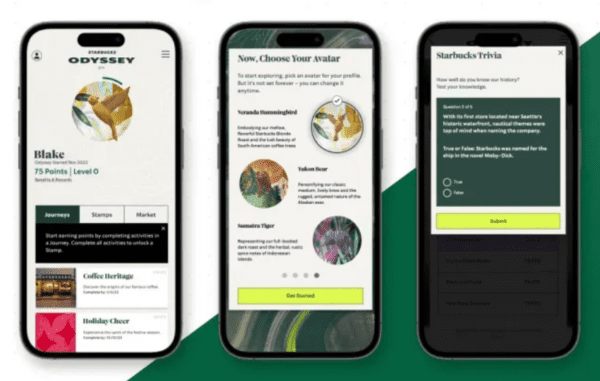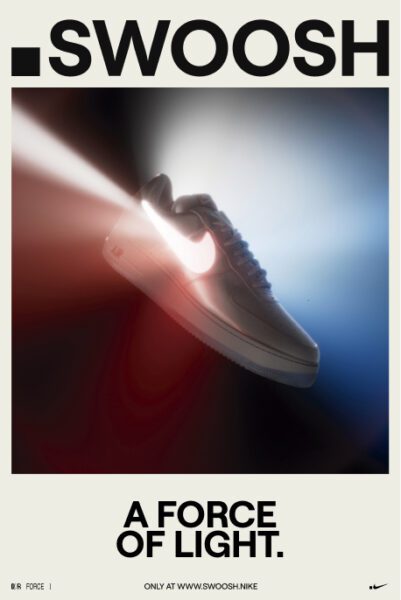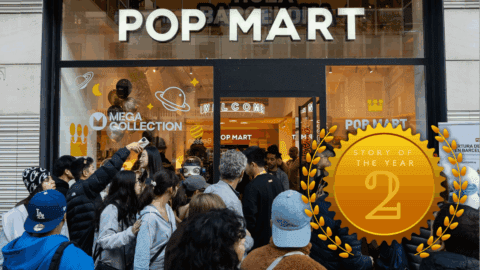In the two years since Christie’s sold a Beeple NFT for $69 million and Justin Bieber paid $1.3 million for his very own “Bored Ape,” some of the shine has worn off of NFTs. Touted as the next big thing in collecting and investing, those splashy million-dollar sales are happening less often, and many folks are now scrambling to offload vastly depreciated digital assets that have been battered by the Crypto Winter. And yet NFTs are still very much a thing — what’s changed is the ways they are being used, which are now much more nuanced, and likely more enduring, than in that first wave of hype-induced frenzy.
“Especially in America, everyone sees things as so binary — something is either there, or it’s dead and we’re moving on, and that’s just not the case, there’s a lot of gray,” said Matt Maher, Founder of M7 Innovations in an interview with Retail TouchPoints. “Digital art pieces and collectibles were shiny for a minute, but now we’re shifting from valuation to value exchange with NFTs, and digital goods are becoming more utilitarian, almost like a ticket.”
“It’s not about the digital collectible anymore, it’s about what does that digital collectible mean,” added Chris Silver, Co-founder of the Web3-based loyalty platform BambuMeta in an interview with Retail TouchPoints. “It’s about flexibility, community, access — I think of it as the next version of omnichannel.”
So what does this new version of omnichannel look like? “The first chapter was about digital scarcity and art and collectibles, but now brands [are realizing that] it’s not just about selling the thing,” explained Tareq Nazlawy, President of the digital assets venture studio ScienceMagic.Studios in an interview with Retail TouchPoints. “It’s an item that people can hold, and they become stakeholders. It’s a new connective tissue, something that can transfer between a brand and a member of a community or even between members within communities, and it has to do with a lot of other things rather than just having financial value.”
As brands like Starbucks, Adidas, E.l.f. Cosmetics, Ticketmaster and Nike begin to experiment with new applications of these technologies, a whole new world is emerging. Silver describes this tech as “the key to personalization; this is the replacement of the cookie,” while Cathy Hackl, Founder and Chief Metaverse Officer at Web3 consultancy Journey, says it’s “the new CRM [customer relationship management].” Either way you look at it, there is vast potential for brands.
Connecting with Consumers in the ‘Cultural Economy’
NFTs and other Web3 technologies are emerging at a time when the relationship between brands and consumers is also undergoing a major transformation. Nazlawy describes this shift as the rise of the “cultural economy,” where “cultural currency builds first, then community comes from that, and products come after.”
But this progression poses a problem for brands that started with products and now must work backwards to build — or in the case of established brands, harness — their communities. “If you’re a brand like Adidas or Nike that has come from the era of, ‘I make products that are great and then I manufacture desire for them,’ you’re competing against a model where belonging is derived before products and services,” said Nazlawy. “So now you have to figure out how to create that sense of belonging. How do you tap into the latent intellectual property and cultural currency that you have, aside from just trying to get people to your website to buy your product?”
Up until now the primary ways to do this were loyalty programs and, more recently, social media, but the world of Web3 is opening up new possibilities to engage with communities in a more interactive and meaningful way. “Digital assets allow you to assign roles, they allow you to reward behaviors, they even allow you to give people access to experiences not just inside your own ecosystem, but outside of it because this token is on a blockchain, it doesn’t live in your database,” explained Nazlawy. “I like using the analogy of NFTs as keys that open doors. What that key looks like could be an avatar, it could be a piece of 2D art, it could be a piece of moving art, but underneath that it also performs the function of a key.”
To illustrate the potential this unlocks, Nazlawy gave an example based on his real-world experience leading Web3 initiatives at Adidas, where he worked for a decade before joining ScienceMagic. A few years ago, he was part of the team working on the Adidas collaboration with Beyoncé’s Ivy Park brand (which is now being discontinued, thus making it perfect fodder for a hypothetical exploration of what could have been).
“I remember there was a tussle because Adidas wanted its members to have priority access [to the Ivy Park collab], and Beyoncé’s team was like, ‘You guys are trying to acquire Beyoncé’s fan, right? The Beehive [as Beyoncé’s fans are known] should have priority too,’” Nazlawy recalled. “But there was no easy way for the Beehive to have priority access to this drop because it was two walled gardens — Adidas members and Beyoncé members. You’re not even allowed to share email addresses anymore. Now, if Beyonce’s fan club was tokenized, you could just say, ‘People with tokens A, B and C inside the Beehive have access to a token-gated drop alongside the most engaged Adidas consumers for 48 hours’ early access,’ and not a single email address would have been needed.”
Taking the hypothetical even further, Nazlawy said it would then have been possible to offer follow-up experiences to the subset of customers who are members of these communities and bought an Adidas x Ivy Park item. For example, those members could get priority access to Beyoncé’s next concert through Ticketmaster (which has just begun enabling token-gated ticket sales).
While Adidas didn’t get there in time for the Ivy Park drop back in 2019, it’s on its way — earlier this month the company added token-gated commerce capabilities to its CONFIRMED app, where it releases its most in-demand products.
One of the truly transformational elements of NFTs is this ability to divide, and combine, segments of a community based on any number of different variables — whether someone showed up to an event or location, their level of participation or if they make a specific purchase, to give just a few examples. This is incredibly powerful, because as Hackl put it, “niche is the new mass market.”
“For the past 20 years brands have had an audience, singular,” said Maher. “You’re always going to have an audience, but within that audience there are going to be loyalists that care more, and brands can now pull that apart and cater to both.”
Ready to explore how to NFTs and Web3 can fit into your business strategy? Then join us at the Retail Innovation Conference and Expo June 13-15, 2023 in Chicago. Futurists Matt Maher and Cathy Hackl will both be speaking at the event alongside executives from across the retail and tech spectrum. Click here to get your all-access pass today!
A True Unlock for Loyalty
The place where brands are finding this most applicable today is with their loyalty programs, many of which could use a bit of an upgrade. “Loyalty programs today all look the same — they all have the same boring benefits and the same ways to earn,” said Silver. “They’re not personalized or contextualized at all.”

But NFTs are changing that, as Starbucks is demonstrating with its new Web3 Odyssey experience, which gamifies the rewards experience by taking visitors on “journeys” where they earn and collect digital assets that unlock access to new benefits and experiences.
While Starbucks Odyssey is available via a separate, standalone app, E.l.f. Cosmetics has integrated its new NFT-based loyalty play — called The Lab and available only to the highest tier of Beauty Squad members — directly into its existing mobile app. Additionally, the initial NFT users create and mint is connected directly to a user’s Apple or Google wallet rather than requiring a separate digital wallet, which is a big step in making these technologies more accessible to everyday consumers.
“It’s as easy as installing a plane or concert ticket; you just click ‘add to wallet,’” said Silver, who helped develop the E.l.f. program. “This opens up what we call an ‘interactional journey,’ because it’s no longer transaction-based [as with many loyalty programs]. Those NFTs create a tokenized profile of that consumer that’s in their Apple wallet. And because it’s in the Apple wallet, it’s now locational so I can reward you, I can message you, I can really engage with you at different hotspots and gamify your interactions with my brand.”
For example, Silver said a brand could automatically send a member rewards points when they walk into a store, remind them that they have a $50 gift card they haven’t used or highlight products they’ve put on their online wish list. “This enables highly personalized messaging that is conveying the value that a member already holds,” Silver explained. “Otherwise, it’s up to you the consumer to remember, wait, I think I have a gift card. Or wait, I have to open up the app and check in to get my points.” And of course, these kinds of prompts and rewards also can be relayed during online interactions.
The more decentralized nature of these types of loyalty programs creates opportunities for cross-brand and cross-channel collaboration. For example, Silver’s company is working with malls to bring together multiple brands in combined loyalty programs.
While providing discounts or promotions “is always one of the best things you can offer to someone to make them feel like you care,” according to Nazlawy, “over and above that are these higher order ways of interacting, creating belonging and even getting into co-creation, which by the way are not necessarily for all your consumers. There has been very little that you can do in the way of lubricating and orchestrating those higher-level relationships between big centralized corporate entities and these small collections of people until now. That’s the difference.”
On the Art of Co-Creation

Co-creation is not something many brands have the capability, or often the desire, to offer. But some brave brands are starting: Nike’s Web3 marketplace .Swoosh debuted its first digital sneaker drop, which was “co-curated” by the .Swoosh community.
Still, the idea of letting consumers have a voice in a brand, and even its products, can be a bit off-putting for some companies. “You cannot let go of the curation of how your brand is perceived, your one responsibility is to protect that — but you don’t have to do all of it,” advised Nazlawy. “There are micro-markets that you will never address with above-the-line marketing because, quite frankly, you don’t know where they all are, you’re too busy making shoes or cars or whatever it is.
“One good example is the fan clubs of soccer teams,” Nazlawy added. “We were just working with a German soccer team that has fan clubs all over the world, and we were like, ‘Why do you create all of your storytelling content in your HQ in Germany? Can’t you empower your fan clubs in Tokyo and Canada to do that for you?’ You’re not asking them for input on how you should play on the field, you don’t have to let go of that. What you should let go of is how the story is told for an audience that you have no idea what they think or feel or why they’re even fans. It’s about tapping into an existing behavior, rewarding those people for that role and letting them grow the cultural capital that surrounds your brand.”
Ready to explore how to NFTs and Web3 can fit into your business strategy? Then join us at the Retail Innovation Conference and Expo June 13-15, 2023 in Chicago. Futurists Matt Maher and Cathy Hackl will both be speaking at the event alongside executives from across the retail and tech spectrum. Click here to get your all-access pass today!















